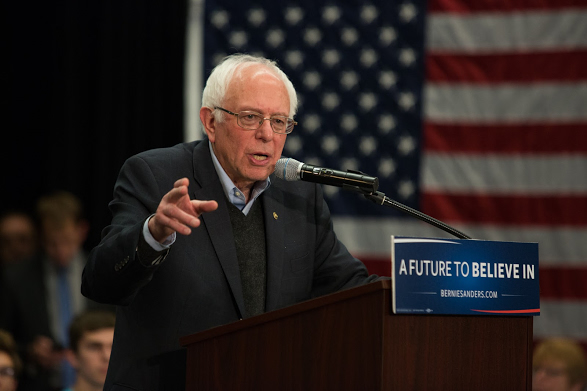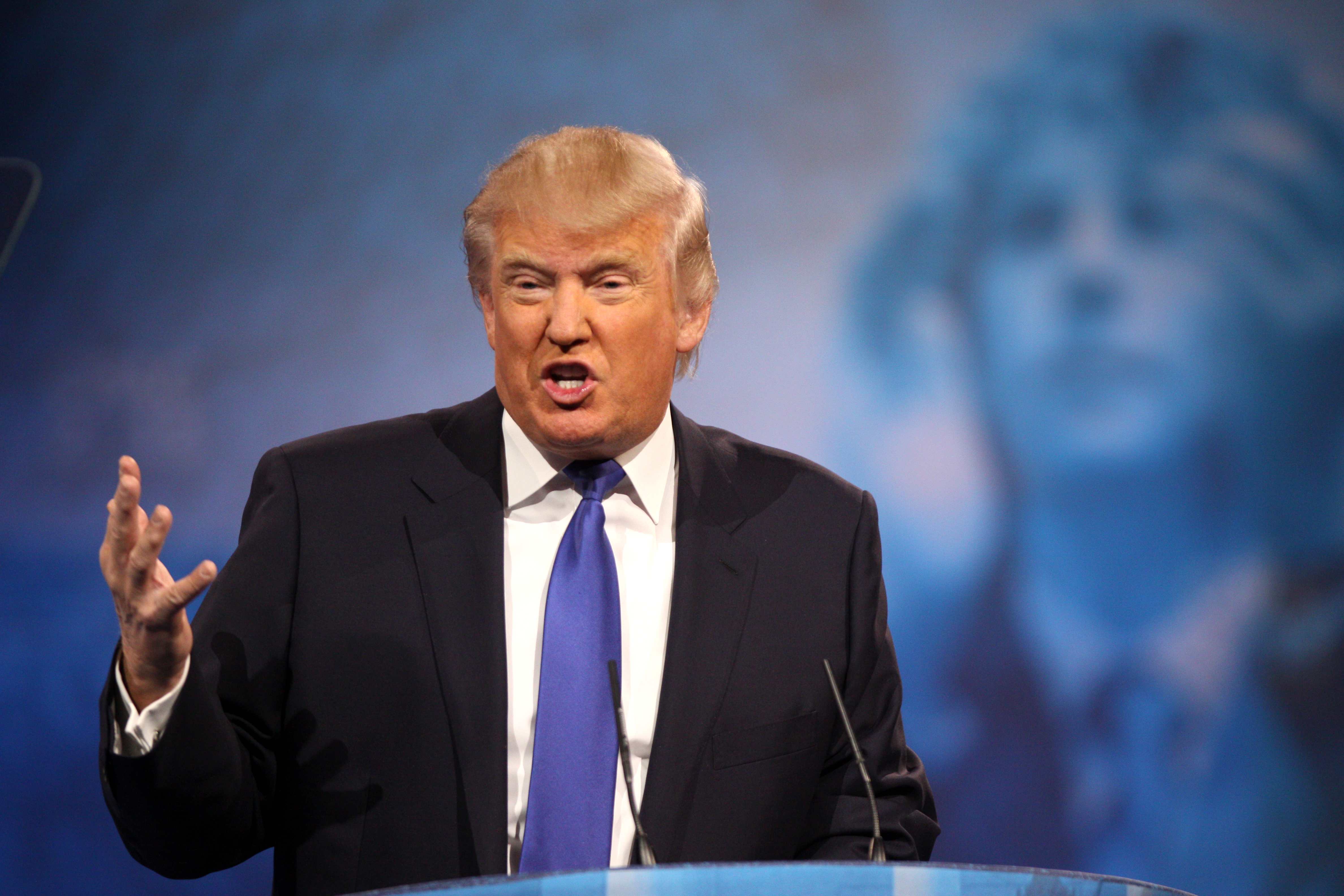www.aljazeerah.info
Opinion Editorials, March 2016
Archives
Mission & Name
Conflict Terminology
Editorials
Gaza Holocaust
Gulf War
Isdood
Islam
News
News Photos
Opinion Editorials
US Foreign Policy (Dr. El-Najjar's Articles)
www.aljazeerah.info
US Presidential Elections 2016:
The Masses Revolt Against the Two Political Establishments
By James Petras

Al-Jazeerah, CCUN, March 1, 2016
 |
 |
| Sanders | Trump |
Introduction
The presidential elections of 2016 have several unique characteristics that defy common wisdom about political practices in 21st century America.
Clearly the established political machinery – party elites and their corporate backers -have (in part) lost control of the nomination process and confront ‘unwanted’ candidates who are campaigning with programs and pronouncements that polarize the electorate.
But there are other more specific factors, which have energized the electorate and speak to recent US history. These portend and reflect a realignment of US politics.
In this essay, we will outline these changes and their larger consequences for the future of American politics.
We will examine how these factors affect each of the two major parties.
Democratic Party Politics: The Context of Realignment
The ‘rise and decline’ of President Obama has seriously dented the appeal of ‘identity politics’ – the idea that ethnic, race and gender-rooted ‘identities’ can modify the power of finance capital (Wall Street), the militarists, the Zionists and ‘police-state’ officials. Clearly manifest voter disenchantment with ‘identity politics’ has opened the door for class politics, of a specific kind.
Candidate Bernie Sanders appeals directly to the class interests of workers and salaried employees. But the ‘class issue’ arises within the context of an electoral polarization and, as such, it does not reflect a true ‘class polarization’, or rising class struggle in the streets, factories or offices.
In fact, the electoral ‘class’ polarization is a reflection of the recent major trade union defeats in Michigan, Wisconsin and Ohio. The trade union confederation (AFL-CIO) has almost disappeared as a social and political factor, representing only 7% of private sector workers. Working class voters are well aware that top trade union leaders, who receive an average of $500,000-a-year in salaries and benefits, are deeply ensconced in the Democratic Party elite. While individual workers and local unions are active supporters of the Sanders campaign, they do so as members of an amorphous multi-class electoral movement and not as a unified ‘workers bloc’.
The Sanders electoral movement has not grown out of a national social movement: The peace movement is virtually moribund; the civil rights movements are weak, fragmented and localized; the ‘Black Lives Matter’ movement has peaked and declined while the ‘Occupy Wall Street Movement’ is a distant memory.
In other words, these recent movements, at best, provide some activists and some impetus for the Sanders electoral campaign. Their presence highlights a few of the issues that the Sanders electoral movement promotes in its campaign.
In fact, the Sanders electoral movement does not ‘grow out’ of existing, ongoing mass movements as much as it fills the political vacuum resulting from their demise. The electoral insurgency reflects the defeats of trade union officials allied with incumbent Democratic politicians as well as the limitation of the ‘direct action’ tactics of the ‘Black Lives Matter’ and ‘Occupy’ movements.
Since the Sanders electoral movement does not directly and immediately challenge capitalist profits and public budget allocations it has not been subject to state repression. Repressive authorities calculate that this ‘buzz’ of electoral activity will last only a few months and then recede into the Democratic Party or voter apathy. Moreover, they are constrained by the fact that tens of millions of Sanders supporters are involved in all the states and not concentrated in any region.
The Sanders electoral movement aggregates hundreds of thousands of micro-local struggles and allows expression of the disaffection of millions with class grievances, at no risk or cost (as in loss of job or police repression) to the participants. This is in stark contrast to repression at the workplace or in the urban streets.
The electoral polarization reflects horizontal (class) and vertical (intra-capitalist) social polarizations.
Below the elite 10% and especially among the young middle class, political polarization favors the Sanders electoral movement. Trade union bosses, the Black Congressional Caucus members and the Latino establishment all embrace the anointed choice of the political elite of the Democratic Party: Hilary Clinton. Whereas, young Latinos, working women and rank and file trade unionists support the insurgent electoral movement. Significant sectors of the African American population, who have failed to advance (and have actually regressed) under Democratic President Obama or have seen police repression expand under the ‘First Black President’, are turning to the insurgent Sanders campaign. Millions of Latinos, disenchanted with their leaders who are tied to the Democratic elite and have done nothing to prevent the massive deportations under Obama, are a potential base of support for ‘Bernie’.
However, the most dynamic social sector in the Sanders electoral movement are students, who are excited by his program of free higher education and the end of post-graduation debt peonage.
The malaise of these sectors finds its expression in the ‘respectable revolt of the middle class’: a voters’ rebellion, which has temporarily shifted the axis of political debate within the Democratic Party to the left.
The Sanders electoral movement raises fundamental issues of class inequality and racial injustice in the legal, police and economic system. It highlights the oligarchical nature of the political system – even as the Sanders-led movement attempts to use the rules of the system against its owners. These attempts have not been very successful within the Democratic Party apparatus, where the Party bosses have already allocated hundreds of ‘non-elected’ so-called ‘mega-delegates’ to Clinton – despite Sander’s successes in the early primaries.
The very strength of the electoral movement has a strategic weakness: it is in the nature of electoral movements to coalesce for elections and to dissolve after the vote.
The Sanders leadership has made no effort to build a mass national social movement that can continue the class and social struggles during and after the elections. In fact, Sanders’ pledge to support the established leadership of the Democratic Party if he losses the nomination to Clinton will lead to a profound disillusionment of his supporters and break-up of the electoral movement. The post-convention scenario, especially in the event of ‘super-delegates’ crowning Clinton despite a Sanders popular victory at the individual primaries, will be very disruptive.
Trump and ‘Revolt on the Right’
The Trump electoral campaign has many of the features of a Latin American nationalist-populist movement. Like the Argentine Peronist movement, it combines protectionist, nationalist economic measures that appeal to small and medium size manufacturers and displaced industrial workers with populist right-wing ‘great nation chauvinism’.
This is reflected in Trumps’ attacks on ‘globalization’ - a proxy for Peronist ‘anti-imperialism’.
Trump’s attack on the Muslim minority in the US is a thinly veiled embrace of rightwing clerical fascism.
Where Peron campaigned against ‘financial oligarchies’ and the invasion of ‘foreign ideologies’, Trump scorns the ‘elites’ and denounces the ‘invasion’ of Mexican immigrants.
Trump’s appeal is rooted in the deep amorphous anger of the downwardly mobile middle class, which has no ideology . . . but plenty of resentment at its declining status, crumbling stability and drug-afflicted families (Witness the overtly expressed concerns of white voters in the recent New Hampshire primary).
Trump projects personal power to workers who bridle under impotent trade unions, disorganized civic groups, and marginalized local business associations, all unable to counter the pillage, power and large-scale corruption of the financial swindlers who rotate between Washington and Wall Street with total impunity.
These ‘populist’ classes get vicarious thrills from the spectacle of Trump snapping and slapping career politicians and economic elites alike, even as he parades his capitalist success.
They prize his symbolic defiance of the political elite as he flaunts his own capitalist elite credentials.
For many of his suburban backers he is the ‘Great Moralizer’, who in his excess zeal, occasionally, commits ‘pardonable’ gaffes out of zealous exuberance – a crude ‘Oliver Cromwell’ for the 21st Century.
Indeed, there also may be a less overt ethno-religious appeal to Trump’s campaign: His white-Anglo-Saxon Protestant identity appeals to these same voters in the face of their apparent marginalization. These ‘Trumpistas’ are not blind to the fact that not a single WASP judge sits on the Supreme Court and there are few, if any, WASPs among the top economic officials in Treasury, Commerce, or the Fed (Lew, Fischer, Yellen, Greenspan, Bernacke, Cohen, Pritzker etc.). While Trump is not up-front about his identity – it eases his voter appeal.
Among WASP voters, who quietly resent the ‘Wall Street’ bailouts and the perceived privileged position of Catholics, Jews and African-Americans in the Obama Administration, Trump’s direct, public condemnation of President Bush for deliberately misleading the nation into invading Iraq (and the implication of treason), has been a big plus.
Trump’s national-populist appeal is matched by his bellicose militarism and thuggish authoritarianism. His public embrace of torture and police state controls (to ‘fight terrorism’) appeals to the pro- military right. On the other hand, his friendly overtures to Russian President Putin (‘one tough guy willing to face another’) and his support to end the Cuban embargo appeals to trade-minded business elites. His calls to withdraw US troops from Europe and Asia appeals to ‘fortress America’ voters, while his calls to ‘carpet bomb’ ISIS appeals to the nuclear extremists. Interestingly, Trump’s support for Social Security and Medicare, as well as his call for medical coverage for the indigent and his open acknowledgement of Planned Parenthood’s vital services to poor women, appeals to older citizens, compassionate conservatives and independents.
Trump’s left-right amalgam: Protectionist and pro-business appeals, his anti-Wall Street and pro-industrial capitalism proposals, his defense of US workers and attacks on Latino workers and Muslim immigrants have broken the traditional boundaries between popular and rightwing politics of the Republican Party.
‘Trumpism’ is not a coherent ideology, but a volatile mix of ‘improvised positions’, adapted to appeal to marginalized workers, resentful middle classes (marginalized WASPs) and, above all, to those who feel unrepresented by Wall Street Republicans and liberal Democratic politicians based on identity politics (black, Hispanic, women and Jews).
Trump’s movement is based on a cult of the personality: it has enormous capacity to convoke mass meetings without mass organization or a coherent social ideology.
Its fundamental strength is its spontaneity, novelty and hostile focus on strategic elites.
Its strategic weakness is the lack of an organization that can be sustained after the electoral process. There are few ‘Trumpista’ cadres and militants among his adoring fans. If Trump loses (or is cheated out of the nomination by a ‘unity’ candidate’ trotted out by the Party elite) his organization will dissipate and fragment. If Trump wins the Republican nomination he will draw support from Wall Street, especially if faced with a Sanders Democratic candidacy. If he wins the general election and becomes President, he will seek to strengthen executive power and move toward a ‘Bonapartist’ presidency.
Conclusion
The rise of a social democratic movement within the Democratic Party and the rise of a sui generis national-populist rightist movement in the Republican Party reflect the fragmented electorate and deep vertical and horizontal fissures characterizing the US ethno-class structure. Commentators grossly oversimplify when they reduce the revolt to incoherent expressions of ‘anger’.
The shattering of the established elite’s control is a product of deeply experienced class and ethnic resentments, of former privileged groups experiencing declining mobility, of local businesspeople experiencing bankruptcy due to ‘globalization’ (imperialism) and of citizens resentment at the power of finance capital (the banks) and its overwhelming control of Washington.
The electoral revolts on the left and right may dissipate but they will have planted the seeds of a democratic transformation or of a nationalist-reactionary revival.
***Share this article with your facebook friends
|
|
|
|
||
|
||||||


